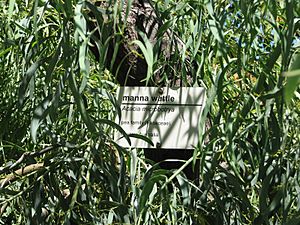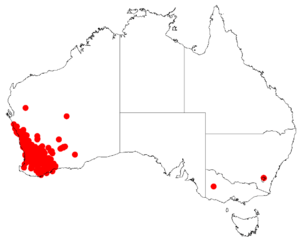Manna wattle facts for kids
Quick facts for kids Manna wattle |
|
|---|---|
 |
|
| A. microbotrya foliage | |
| Scientific classification | |
| Genus: |
Acacia
|
| Species: |
microbotrya
|
 |
|
| Occurrence data from AVH | |
The Acacia microbotrya, often called manna wattle or gum wattle, is a type of shrub or tree. It belongs to the Acacia family and is found naturally in Western Australia.
The Noongar people, who are the traditional owners of the land, have several names for this tree. They call it Badjong, Galyang, Koonert, or Menna.
Contents
What Does the Manna Wattle Look Like?
The Manna wattle is a bushy plant that can be a shrub or a small tree. It usually grows about 2 to 7 meters (6 to 23 feet) tall. Its branches can spread out up to 5 meters (16 feet) wide, creating a nice shady spot.
It has smooth branches and rough, brown bark on its trunk. Its leaves, called phyllodes, are long and thin, shaped like a spear or a narrow oval. They hang down and are a grey-green color. Each phyllode is smooth and olive green. They are usually 5 to 14 centimeters (2 to 5.5 inches) long and 5 to 20 millimeters (0.2 to 0.8 inches) wide.
Flowers and Seed Pods
This wattle blooms from March to August, showing off pretty yellow-cream flowers. Its flowers grow in clusters called inflorescences. These clusters are like small branches, 1.5 to 4 centimeters (0.6 to 1.6 inches) long. At the end of these branches are round flower heads. These heads are cream to pale yellow, about 4 to 6 millimeters (0.16 to 0.24 inches) across, and each contains 20 to 30 tiny flowers.
After the flowers, dark brown to blackish seed pods grow. These pods are smooth and look like a string of beads because they are squeezed in at regular spots. They are quite long, about 15 to 20 centimeters (6 to 8 inches) in length, and 6 to 8 millimeters (0.24 to 0.31 inches) wide. Inside these pods are shiny black seeds. The seeds are oblong or oval-shaped, 5.5 to 8 millimeters (0.22 to 0.31 inches) long and 4 to 5 millimeters (0.16 to 0.20 inches) wide.
How Scientists Name the Manna Wattle
The Manna wattle was first officially described by a botanist named George Bentham in 1842. He wrote about it in a book called Notes on Mimoseae, with a synopsis of species.
Scientists sometimes change the names of plants as they learn more. In 2003, it was briefly called Racosperma microbotryum. But in 2014, it was moved back to the Acacia group, which is its current name.
Related Wattle Species
The Manna wattle is very closely related to two other wattle species: Acacia amblyophylla and Acacia jennerae. It also looks a lot like Acacia galeata and Acacia saligna.
There are also two known types, or variations, of the Manna wattle:
- Acacia microbotrya var. borealis
- Acacia microbotrya var. microbotrya
Where the Manna Wattle Grows
The Manna wattle is native to several regions in Western Australia. You can find it in the Wheatbelt, Great Southern, and Goldfields-Esperance areas.
It likes to grow in rocky areas, near rivers and streams, and around salt lakes. You might also see it along the sides of roads. It prefers clay loam or sandy loam soils, often growing over granite rock. Most of these plants are found from Kalbarri in the north, south-east to around Katanning. There are also smaller groups of them further east near Ongerup and Lake King.
Why People Grow Manna Wattle
You can buy Manna wattle as seeds or as small plants (called tubestock). People often use it in gardens that feature native Australian plants. It's also helpful for fixing up land that has been damaged.
This plant is popular because it grows quickly and can handle salty soil. It can even survive in areas where the ground gets waterlogged. It's used as an ornamental plant (meaning it looks nice), as a windbreak to protect other plants, and for shelter. It can also be used for growing sandalwood.

